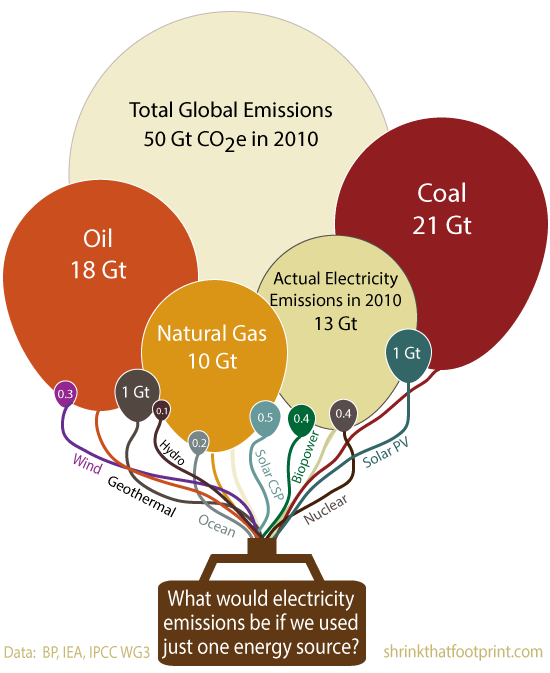Low carbon electricity is a wonderful thing, and will be a central part of tackling climate change.
In 2010 electricity generation was responsible for about 13 Gt of greenhouse gas emissions, or a little bit more than a quarter of all emissions. The rest came from industry, transport, buildings, agriculture, forestry and waste.
The thing that is exciting about electricity from a climate standpoint is that we actually have technology which can slash its emissions. To help provide some clarity and context as to the relative importance of low carbon electricity this post tests a simple idea.
What would global electricity generation emissions look like if the world used just one generation technology?
In 2010 the world generated 21,400 TWh of electricity which resulted in emissions of 13 Gt CO2e (the beige balloon) given the current fuel mix. Using the central estimates from the IPCC’s excellent meta-study of electricity generation lifecyle assessments we can estimate what these emissions would look like using just one technology.
The results are stark.
Using Coal 21,400 TWh would result in 21 Gt CO2e, for Oil it is 18 Gt and for Natural Gas it is 10 Gt. In contrast Geothermal and Solar PV are 1Gt, Solar CSP is 0.5, Biopower and Nuclear 0.4, Wind 0.3, Ocean 0.2 and Hydro 0.1 Gt.
The gap between fossil fuels and the rest is a chasm.
These numbers deserve some global context. To have a decent chance of keeping climate change to 2ºC we need to cut global emissions to something like 20 Gt CO2e by 2050, and down towards zero by the end of the century. That is down from 50 Gt in 2010.
If we clicked our fingers tomorrow and switched all the coal, gas and oil electricity generation in the world to low carbon sources, we’d still be at 37 Gt. A long way from a stable climate.
But the 13 Gt we currently emit isn’t where the abatement potential of low carbon electricity ends.
A further 20 Gt of current emissions result from transport, industry and buildings. Large swathes of which have the potential to be electrified and benefit from low carbon electricity.
The remaining emissions from deforestation, agriculture and waste need their own solutions. And when you consider that energy demand is likely to increase by 50-100% by 2050, we could really do with some negative emission technologies too.
You see, low carbon electricity really is a wonderful thing.
Are you getting any?










